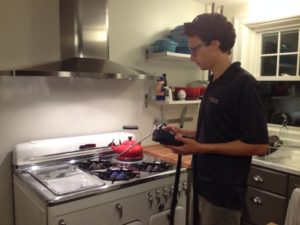- August 13, 2015
- 0 Comments
- In Existing Building Performance
- By
I love to cook. And like most cooks, I love to cook on my gas range. But I am also a building science researcher, and the researcher in me doesn’t understand how we allow gas ranges in homes. Building codes and energy efficiency programs have pushed the housing market towards all combustion appliances being sealed combustion and direct vent. Our furnaces, boilers, water heaters, and fireplaces are all going towards sealed combustion. Soon it is likely that building codes won’t even give you the option of using open combustion devices. This push for sealed combustion is an effort to drastically reduce the health hazards of carbon monoxide poisoning and other contaminants in our homes. As a researcher, this makes complete sense to me…but I, like many others, say “Don’t touch my gas range.”
A gas range has the potential to have four-to-six gas burners on, along with a gas oven (though I wish my oven was electric). Each burner typically ranges from 5,000-15,000 BTUs and the oven is typically 16,000-17,000 BTUs. That can add up to more heat output then a typical furnace, but we don’t even require that the combustion fumes be exhausted outdoors. Codes are now requiring a kitchen exhaust hood to be installed and ducted to the outside, but it doesn’t ensure that all the exhaust fumes are exhausted, especially if the cook doesn’t turn on the exhaust fan, which is a far too common occurrence. Even if they are turned on, kitchen hoods are typically undersized (not in terms of cubic feet per minute of exhaust air flow, but with respect to capture efficiency of the hood¹ ) due to aesthetics to adequately remove the majority of contaminants. Next time you are cooking, take a look at your kitchen hood. You are likely cooking on the front two burners, but your kitchen hood is not likely to extend fully over these burners. Furthermore, if you only have a recirculation exhaust fan, you should really be thinking long and hard about your safety and install a kitchen hood that exhausts to outdoors.
Whether you are just boiling some water for a cup of tea or making a Thanksgiving feast, please make sure to always turn on the exhaust fan when cooking with a gas range. And don’t forget, this means when you are using the gas oven as well.
While I love to cook on my gas range, I continue to worry about indoor air quality. And based on feedback from some of my cooking friends, an induction cooktop might just be the answer to my conundrum.

